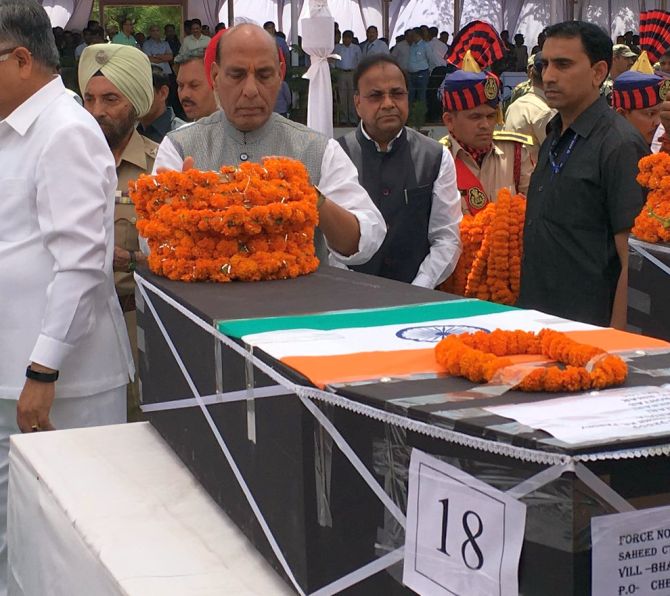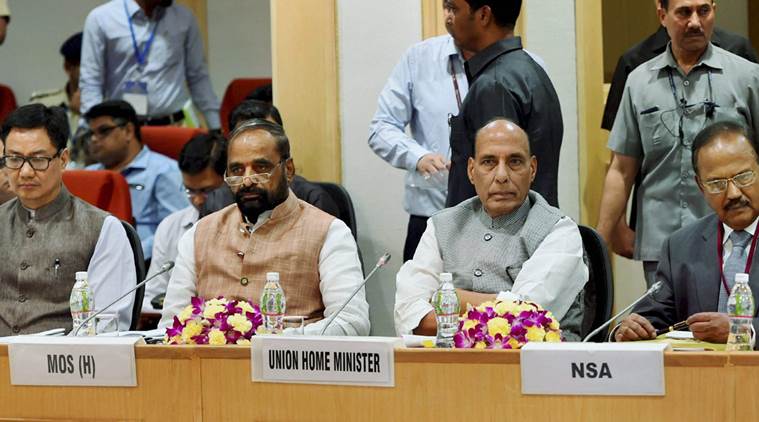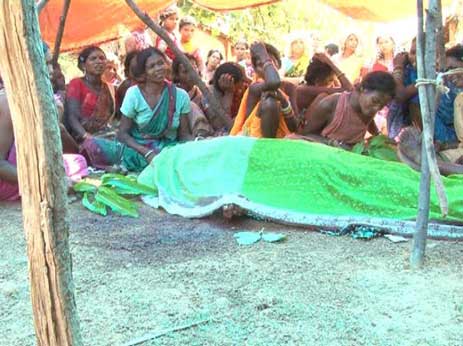MANTRAYA SPECIAL REPORT#10: 22 MAY 2017
Intelligence and Counter-intelligence in India’s Maoist theatres
–
Bibhu Prasad Routray
–
Abstract
A single big extremist attack can reverse the narrative of optimism regarding India winning the war on left-wing extremism (LWE). Such an attack can lead to a barrage of charges and counter charges on the range of deficiencies that affects New Delhi’s counter-LWE policy. The 24 April attack in Chhattisgarh’s Sukma district is a case in point. The neatly planned attack that resulted in the death of 25 Central Reserve Police Force (CRPF) personnel just not turned the previous official claim of a near-victory over LWE on its head, but opened a can of worms revealing the deficiencies that continue to mar the war on extremism in the past few years. This article takes stock of one such shortcomings, i.e. the lack of ground level intelligence.
–
The Black Hole
(Home Minister Rajnath Singh paying homage to the CRPF personnel killed in the 24 April 2017 attack in Sukma)
Twenty-five Central Reserve Police Force (CRPF) personnel killed, 25 high calibre rifles looted, and a major setback to New Delhi’s claim of winning the war on the Communist Party of India-Maoist (CPI-Maoist). This summed up what took place on 24 April 2017 in Sukma, one of the worst left-wing extremism affected districts in India’s Chhattisgarh state. For days, police and intelligence officials debated not just over how could 300 extremists assemble and execute such an attack without anybody taking notice, but also on the identities of the extremists who led the attack. Was it Hidma, the chief of a CPI-Maoist battalion? Or is it one if his two confidants- Pada Appu and Bhagat? Or was it one of the senior commanders- Situ, Sonu or Nagesh? One of the senior Chhattisgarh police officials asserted his ‘belief’ that an ailing Hidma could not have been involved. But the Intelligence Bureau (IB) insisted on the involvement of Hidma. India’s Home Ministry, however, admitted that neither Chhattisgarh police nor the central intelligence agencies possess recent photographs of any of the top Maoist leaders. India, it seems, is fighting the left-wing extremists in the dark.
The Big Bane
Lack of ground level intelligence has remained the biggest bane in India’s fight against LWE. Blamed usually on the Maoists killing police informers, the absolute lack of intelligence amounts to negligible advance information on a variety of Maoist activities relating to their expansion plan and inroad attempts into new areas, recruitment and extortion activities, and also crucially, build up of cadres and their movement prior to an attack. The Central Armed Police Forces (CAPFs) like the Central Reserve Police Force (CRPF) rely heavily on the local police for such inputs. However, over the years, CAPFs have alleged that intelligence flow from the police has been qualitatively as well as quantitatively inadequate.
To tide over this challenge, in 2012, CRPF developed its own intelligence wing. Then Home Minister P Chidambaram acceded to the CRPF’s long-pending demand of a separate Intelligence cadre to be deployed in the LWE affected areas. Each battalion was to have eight such personnel, 12 DIG officers were to be appointed, and at the range level 16 officers were to supervise the intelligence collection. A school to train personnel for the purpose was established at CRPF’s Kadarpur academy in Haryana and was headed by a former chief of the Border Security Force (BSF)’s G-branch for intelligence. In the first two years, the school imparted training to 1000 personnel, who were mostly deployed in the LWE affected areas. An impact assessment of the initiative summed up: “The efficacy of the trained persons reflected very well on ground as their quotient in Intelligence generation had already reached 20% on whose basis the CRPF had managed to carry out several successful seizures and escape ambush traps laid out by the Maoists.”[1] However, in March 2014, the school was shut down owing to resource crunch.[2] And since then, the CRPF reverted to rely on intelligence gathered by the state police.
While relying on the local police intelligence makes enormous operational sense, the mechanism for the purpose is affected by a range of logistical as well as other deficiencies. First, the LWE problem overburdens the already stressed special branch of the state police that oversees intelligence collection. Police departments in all most all the LWE-affected states suffer from huge vacancies affecting their ground operations as well as intelligence collection. Some states have attempted to address this lacunae by fast tracking recruitment. But this has led to a serious compromise on the quality of personnel recruited. Second, due to operational and security reasons, some of the police stations function inside the CRPF camps.[3] While this may have ensured security for the stations, their garrisoned location has dented the intelligence collection activities. Third, poor representation of tribals in the police department has resulted in a communication problem between the non-tribal policemen and the tribals who usually do not speak the mainstream language. The fact that a divide that is cultural and one which is rooted in perceptions and stereotyping separates the non-tribal officers from the handful of tribal personnel has not led to the effective integration of the latter into the department.[4]
Apart from the police, the Intelligence Bureau (IB) too is mandated to collect intelligence in the Maoist belt. However, the nature of impediments which the police faces, afflicts the IB as well. Several reports[5] have pointed at the acute shortage of field level officers within the IB. Such shortages are believed to be even worse in the LWE affected areas. IB’s primary focus on generating political intelligence makes its contribution regarding LWE related activities far less effective. These limitations notwithstanding, the BJP-led government in New Delhi continues to hope that the IB will be able to penetrate into the CPI-Maoist’s inner ring and provide actionable intelligence. Rajnath Singh, since becoming Home Minister in 2014, has spoken on multiple occasions about such a strategy to target the top CPI-Maoist leadership. The fact that the new anti-LWE doctrine SAMADHAN, unveiled on 8 May 2017[6], reiterated the need for a proactive IB role indicates that the agency is yet to implement the Home Minister’s two year old directive.
The persisting problem of the state agencies failing to generate actionable intelligence on the Maoist movement has been sought to be addressed by enlisting tribal vigilante groups. State sponsored movements like the Salwa Judum consisting of tribal men consisting of surrendered Maoists as well as unemployed youths not only brought in the much required intelligence but also boosted the security force efforts through their actual participation in anti-Maoist operations. However, very soon wide ranging excesses committed by these groups negated this advantage. Groups like Salwa Judum were no longer representative of the tribals, but had become a recognised arm of the state. The same schism that divided the state and the tribals, divided the vigilante groups and the tribals.
Following a Supreme Court ban on Salwa Judum[7], the Chhattisgarh police inducted these Salwa Judum men into the regular police force as District Reserve Guards (DRG) personnel.[8] The DRG has since received extensive training in counter-insurgency techniques boosting its war fighting abilities. However, generating intelligence or being a slice of the state living within the population is no longer its forte.
HUMINT Vs TECHINT
(Home Minister Rajnath Singh chairing a meeting of Chief Ministers of LWE affected states in New Delhi on 8 May 2017. It is during this meeting that a new counter-LWE doctrine SAMADHAN was unveiled.)
To supplement the human intelligence (HUMINT), unmanned aerial vehicles (UAVs) have come to the aid of the forces in Chhattisgarh. Flown by the National Technical Research Organisation (NTRO), the UAVs, till 2013, undertook sorties from a base in neighbouring state of Andhra Pradesh. Efforts to get the base located closer to the LWE heartland gained momentum after security forces complained about the huge delay between generation of imagery and ground level reaction. In 2013, a base in Bhillai, much closer to Bastar, was operationalised. Speaking on the occasion, the CRPF chief commented that his forces would no longer have to conduct “Rambo style operations”, the operations would hence be based on “specific intelligence”, and would aid his objective of ensuring “fewer or zero casualties”among personnel in anti-Maoist operations.[9]
According to available data from the MHA, between 1 January 2014 and 30 April 2017, 271 security force personnel have been killed in the LWE-affected states. A part of the blame for these deaths have been labelled on the UAVs. First, the infra-red rays emitted by the synthetic aperture radar were unable to penetrate foliage in the jungle and hence, the images were considered ‘not actionable’ by the forces.[10] Second, there are instances of lack of synergy between the NTRO operations and the requirement of the forces. In December 2014, the CRPF alleged that the NTRO unilaterally pulled back an UAV mid-way an operation that had been launched after 14 CRPF personnel had been killed. Secondly, even the UAV inputs regarding real time Maoist build up has not been effective as an SOP governing CRPF operations prohibits the forces from undertaking big operations without clearance from the headquarters. The time gap between such clearances and generation of inputs invariably allows the Maoists to shift from their vulnerable positions to more secure ones.
The Maoist Counter-Intelligence
Even as the security forces have struggled either to generate intelligence or even to put available intelligence to use, the Maoists have excelled in their counter-intelligence manoeuvres.
Threatening to harm and/or killing police informers has been an old strategy of the Maoists to keep the area under their control free from state influence. A warning followed by killing of police informers mostly in hastily convened praja courts in full view of the tribals has, for years, been able to maintain a cloud of fear and trepidation in the tribal areas. According to the Ministry of Home Affairs (MHA), between 2011 and April 2017, the CPI-Maoist killed 813 police informers in the LWE affected areas. Interestingly in 2015 and 2016, the proportion of police informers among the civilians killed by the CPI-Maoist has increased, indicating the outfit’s increasing weariness regarding state’s inroads into its strongholds and ruthless implementation of a purging strategy. In 2011, for example, among the 469 civilians killed in LWE violence 218 were police informers. The ratio was 46 percent. In 2012, the ratio dipped to 44 percent. However, for 2015 and 2016, the years in which the state claimed gains into the CPI-Maoist strongholds, the ratio increased to 55 and 57 percent respectively. Killings serve a far reaching purpose. They eliminate important sources that the state had painstakingly cultivated, and also effectively bar entire villages from communicating with the state authorities.
(Villagers mourn the killing of a tribal police informer by the Maoists in a Praja court in Odisha, 2014)
Passing of information happens either through phone calls or during conversations in the weekly village markets where policemen in civvies interact with their sources. Village heads, being representatives of the state, are required to report on Maoist movements, their entry into villages, and other activities and hence, have become special persons of interest for the Maoists. Not surprisingly, a number of tribal sarpanch, are among the police informers killed in the past years. Moreover, the CPI-Maoist in several villages has strictly banned villagers from owning cell phones and its cadres have made surprise checks on call records of existing phones. Its cadres also keep a close watch on the village markets to single out villagers indulging in lengthy conversations with outsiders. Interrogation and on occasions, punishment can follow any unusual delay in returning from village markets. Such measures restrict the flow of intelligence from the ground level to the police, leaving the forces to rely more on technical intelligence to track Maoist activities.
Conclusion
To deal with the LWE threat, India’s Home Ministry has consistently pushed the ‘kill the top leaders to kill movement’ theory in recent years. Such a belief is based on the impact the killing of senior Maoist leaders on the trajectory of the extremist movement in states like Andhra Pradesh and West Bengal. However, to replicate the same in a state like Chhattisgarh, justifiably described as one of the last bastions of the LWE movement, the state needs to invest in and get its act together on generating real time intelligence. This is unlikely to happen neither through the proposed ‘infiltration’ into the CPI-Maoist’s ranks, nor by deployment of additional forces. What is required is meticulous work at the ground level to ensure the following: (i) HUMINT flows seamlessly from the affected people to the security establishment; (ii) Augmenting the state’s capacity to act on the generated TECHINT; (iii) the state’s genuine desire and actions to win the trust of the tribal population.
References
[1] Manan Kumar, “CRPF closes down its Intelligence School”, DNA, 15 March 2014, http://www.dnaindia.com/india/report-dna-special-crpf-closes-down-its-intelligence-school-1969491. Accessed on 2 May 2017.
[2]Nishit Dholabhai, “Schools shut, CRPF suffers”, Telegraph, 14 March 2014, https://www.telegraphindia.com/1140314/jsp/nation/story_18079955.jsp#.WRFoKfl97IU
[3]Chintagufa police station, the closest police station to the location of the 24 April 2017 attack in Sukma district
Burkapal functions inside the CRPF campus, leaving no scope for generating intelligence.
[4]During my field visit in Jharkhand, a non-tribal Superintendent of Police of an LWE-affected district referred to his tribal constables are “drunkards, irresponsible and unreliable”. Such stereotyping of tribal police personnel is not an isolated, but is rather rampant across states.
[5] Praveen Swami, “Five years after 26/11, Intelligence services still crippled by staff shortage”, The Hindu, 26 November 2013, http://www.thehindu.com/news/national/five-years-after-2611-intelligence-services-still-crippled-by-staff-shortage/article5391698.ece. Also see Praveen Swami, “India’s spy agencies more toothless than ever”, The Indian Express, 1 December 2014, http://indianexpress.com/article/india/india-others/indias-spy-agencies-more-toothless-than-ever/ and “Gujarat police officers wary of joining the Intelligence Bureau”, Times of India, 2 September 2016, http://timesofindia.indiatimes.com/city/ahmedabad/Gujarat-police-officers-wary-of-joining-the-Intelligence-Bureau/articleshow/53986012.cms
[6] “Union Home Minister addresses the Review Meeting of Left Wing Extremism affected States “, Press Information Bureau, 8 may 2017, http://pib.nic.in/newsite/PrintRelease.aspx?relid=161625
[7] J Venkatesan, ” Salwa Judum is illegal, says Supreme Court”, The Hindu, 5 July 2011, http://www.thehindu.com/news/national/Salwa-Judum-is-illegal-says-Supreme-Court/article13639702.ece
[8] Sonia Sarkar, “Uncivil War”, Telegraph, 20 November 2016, https://www.telegraphindia.com/1161120/jsp/7days/story_120173.jsp
[9]“No ‘Rambo-style’ operations in Naxal areas, SOPs being revised: CRPF”, Indian Express, 15 March 2015, http://indianexpress.com/article/india/india-others/no-rambo-style-operations-in-naxal-areas-sops-being-revised-crpf/. Accessed on 5 May 2017.
[10] On one occasion in December 2011, security forces launched an operation, on the basis of the images provided by the UAV, to find that the target elected is a village and not a Maoist camp. See Yatish Yadav, “Heron drone proves a dud in tracking Maoists in Chhattisgarh”, India Today, 3 January 2012, http://indiatoday.intoday.in/story/heron-uav-fails-to-track-maoists-in-chattisgarh/1/166919.html
(Bibhu Prasad Routray is Director, Mantraya. This Special Report is published as part of Mantraya.org’s ongoing “Mapping Terror and Insurgent Network” projects.)
To download a PDF version of this special report click here: Intelligence and Counterintelligence in India’s Maoist theatres
To Read previous Special Reports, CLICK HERE





